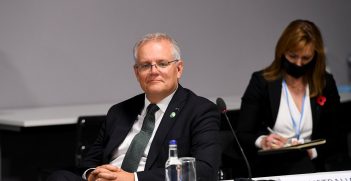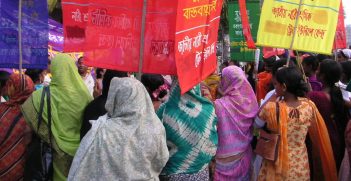Fifty Years of Singapore-Bangladesh Ties: Shared Past, Robust Future

The golden jubilee of Bangladesh and Singapore signifies a watershed moment in the two democratic countries’ long-standing friendship. Although the relationship remains arguably underdeveloped, exciting bilateral opportunities are just around the corner.
Bangladesh and Singapore, at birth, had similar stories to tell. In 1965, when Singapore was expelled from the Federation of Malaysia due to irreconcilable differences and thrust into an unsought independence, development experts had little reason to get excited about the newborn Southeast Asian “fishing village.” Over time, Singapore was gradually crowned one of the most progressive economies in the world — despite being constrained by space, resources, and population size — under the charismatic leadership of Lee Kuan Yew, who as a young man witnessed his homeland be shattered by the imperial evils of World War II.
Six years after Lee’s ascension to power in Singapore, Bangladesh emerged in South Asia in 1971 under the messianic leadership of Bangabandhu Sheikh Mujibur Rahman, the Father of the Nation. The blood-soaked birth of Bangladesh was met with similar scepticism from academics, perhaps epitomised by then US National Security Advisor Henry Kissinger’s infamous description of the country as a “bottomless basket.” Like Singapore, Bangladesh also has a magnificent story to tell, one that defies all odds and assumptions.
Lee and Mujib, the architects of their respective nations, shared a dream. Both desired to emancipate their nations from the evils of oppression and transform them into developed ones. In doing so, the national heroes were prudent to foresee a shared future of Singapore-Bangladesh ties by establishing formal diplomatic relations on 16 February 1972. The Singapore-Bangladesh bonhomie scaled new heights as it marked a half-century this year. At this auspicious moment, it is worth stepping through the strengths, challenges, and possible opportunities ahead that have sprung from this unique bilateral relationship.
Trade and Investment
Singapore is Bangladesh’s third-largest import partner, while Bangladesh is Singapore’s second-largest trading partner in South Asia. The trade volume amounted to US$2.59 billion in 2020. Singapore mainly exports machinery and intermediate goods to Bangladesh, while garment products and agricultural products are key imports. In November 2021, the two countries began negotiations for a free trade agreement (FTA), designed to open up a sprawling expanse of trading turf that spans the Southeast Asian and Asia-Pacific regions. Singapore is the third-largest investor in Bangladesh and has mostly invested in the sectors of power, energy, transport, logistics, and marine trade.
However, as Bangladesh transitions from a supplier of low-skilled employees to a source of skilled professionals, Singapore should eye the nation’s developing human resource sector for potential future investment. Both states have also taken similar initiatives — “Smart Nation” in Singapore and “Digital Bangladesh” — to deliver tech-enabled solutions to their citizens by merging information technology, networks, and big data. Therefore, both countries look poised to foster deeper collaboration in the fields of ICT, digitalisation, and cyber security.
One of the key factors that fuelled the economic miracle in Bangladesh was an adequate supply of electricity — with over 23,000 MW of installed power generation capacity nationwide. Bangladesh will need an estimated 34,000 MW of power by 2030 to sustain its current level economic growth and achieve the sustainable development goals (SDGs), a collection of 17 interlinked global goals to achieve a better and more sustainable future for all. In addition, the government of Bangladesh has set a new roadmap to produce 40 percent electricity from renewable sources by 2050. Taking advantage of the friendly investment climate in Bangladesh and the government’s preference for both onshore and offshore gas and oil exploration and distribution, Singaporean investors can continue to grasp the investment opportunity in these thriving sectors.
People-to-People Contacts
Historically, being a human resource reliant country, Singapore has utilised foreign human resources to supplement the local workforce. Fortuitously, Bangladesh — the world’s eighth-most populous nation — is a natural reservoir of people-power for Singapore. Around 16,0000 Bangladeshi migrants are currently employed in Singapore, mostly in the construction, maritime, and processing industries. The work conditions and wages in Singapore are favourable for Bangladeshi workers, who sent home remittances worth around $625 million in 2021. Bangladesh Bank reports that the Bangladeshi remittances received from Singapore are three times larger than the value of its exports to Singapore.
Shared Concerns
Singapore spans the seam of the strategically vital Malacca Strait and the South China Sea, while Bangladesh is located in the heart of the Bay of Bengal. Both states possess “pivotal” geostrategic locations in the Indo-Pacific region. Till now, both countries have pursued a “balanced approach” as the cornerstone of their foreign policy, attempting to avoid the perils of geopolitical rivalries and the pitfalls of bandwagoning to safeguard their national interests.
In addition, Singapore and Bangladesh share a similar outlook on many issues of global concern in international fora, including in the UN, the Commonwealth, and the World Trade Organization (WTO). For now, the major diplomatic snag for Bangladesh is the ongoing Rohingya crisis resulting from a military crackdown in Myanmar. Since the influx of the Rohingya refugees, Singapore continues to complement Bangladesh’s humanitarian assistance for the Rohingya crisis and gave assurance of its “sincere and continued efforts” in finding a durable solution to the Rohingya crisis.
According to Germanwatch’s 2021 Global Climate Risk Index (CRI), Bangladesh is the seventh most vulnerable country to climate change. Similarly, Singapore, being a low-lying island with nearly a third of its territory only five meters above mean sea levels, it is highly vulnerable to climate change. Motivated by similar concerns, both nations must work on addressing environmental challenges and should look to strengthen cooperation on natural disaster management.
Untapped Opportunities
Over the past two decades, Bangladesh’s annual economic growth has sat at six percent, transforming it from a “bottomless basket” into a “South Asian miracle.” It plans to graduate from the category of Least Developed Countries (LDC) by 2026. Singapore is a node in the global supply chain and a core member of many regional and trade regimes, including the ASEAN, the RCEP, and CPTPP. Although the two states share some history, it is time for Bangladesh to bolster its ties with Singapore to diversify and boost its economic and regional engagements. To ensure its sustainable graduation from LDC, Bangladesh needs to negotiate an extension of the duty privilege at the next WTO Ministerial Conference (MC-12). Bangladesh’s LDC graduation will lead to not being able to benefit from certain provisions under the WTO, which may have instrumental implications for the country’s policy space. As a leading member of WTO and committed to collaborating with like-minded partners, Bangladesh might expect Singaporean support in these negotiations.
The 50th anniversary of diplomatic relations between Bangladesh and Singapore signifies a watershed moment in the two democratic countries’ long-standing friendship spanning. In the coming days, the bilateral cooperation should be widened by exporting people-power, attracting foreign investment, initiating cooperation to tackle the common threat of security, terrorism, and radicalisation, and pursuing an active role within the UN and other regional and international systems to ensure mutual interest and robust future.
Shaikh Abdur Rahman is currently working as a research assistant at the Central Foundation for International and Strategic Studies (CFISS) based in Dhaka. He finished his master’s in international relations from the University of Rajshahi, Bangladesh.
This article is published under a Creative Commons License and may be republished with attribution.





